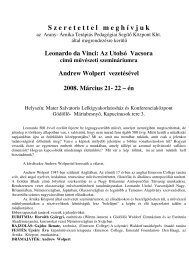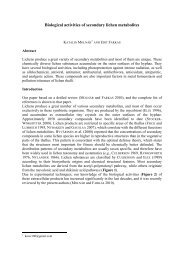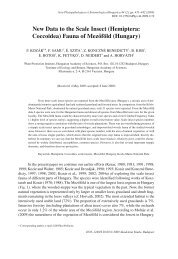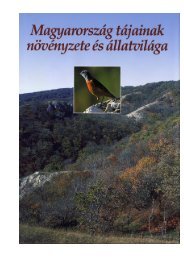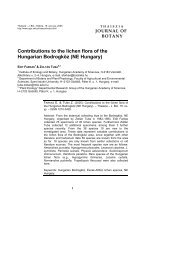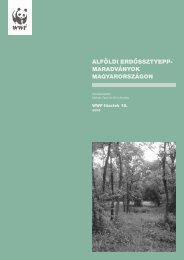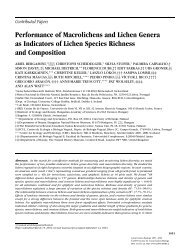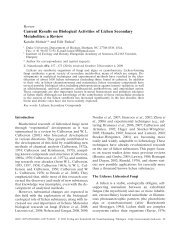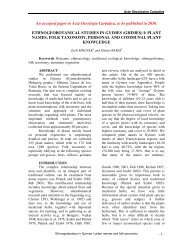Floodplain hay meadows along the river Tisza in Hungary
Floodplain hay meadows along the river Tisza in Hungary
Floodplain hay meadows along the river Tisza in Hungary
Create successful ePaper yourself
Turn your PDF publications into a flip-book with our unique Google optimized e-Paper software.
and has caused <strong>the</strong> loss of a number of habitats. The value of <strong>the</strong><br />
landscape is vanish<strong>in</strong>g even more seriously before our very eyes. The<br />
heterogeneity and dynamism of <strong>the</strong> landscape, mentioned <strong>in</strong> <strong>the</strong><br />
previous section, implies that land use will significantly determ<strong>in</strong>e<br />
<strong>the</strong> dest<strong>in</strong>y of this region <strong>in</strong> <strong>the</strong> future, just as it did <strong>in</strong> <strong>the</strong> past. If <strong>the</strong><br />
grasslands are not mown <strong>in</strong> <strong>the</strong> future and <strong>the</strong> shrubs <strong>in</strong>vad<strong>in</strong>g <strong>the</strong>m<br />
are not cleared from <strong>the</strong>se areas, <strong>the</strong> grasslands will be replaced by<br />
<strong>the</strong> spontaneously extend<strong>in</strong>g thickets of Amorpha fruticosa. The vast<br />
majority of grasslands will disappear, and most of <strong>the</strong>ir species will<br />
vanish as a result of allelopathy and shad<strong>in</strong>g by Amorpha fruticosa. It<br />
is likely that o<strong>the</strong>r <strong>in</strong>troduced woody species will also appear, such<br />
as Frax<strong>in</strong>us pennsylvanica and Acer negundo and lianas. In about 20-30<br />
years, <strong>the</strong> <strong>in</strong>vasion of trees and lianas will transform <strong>the</strong> former <strong>hay</strong>fields<br />
and wooded <strong>hay</strong>fields <strong>in</strong>to dense <strong>river</strong><strong>in</strong>e thickets dom<strong>in</strong>ated<br />
by non-native species. The effects of <strong>the</strong> eradication of Amorpha<br />
Table 1. Characteristics of typical species of floodpla<strong>in</strong> <strong>meadows</strong>.<br />
Typical species<br />
Abundance <strong>in</strong> <strong>the</strong><br />
<strong>Tisza</strong>-valley<br />
IUCN<br />
Categories 2001<br />
Near Threatened<br />
Flora element<br />
fruticosa thickets and <strong>the</strong> mow<strong>in</strong>g of grasslands can be determ<strong>in</strong>ed<br />
unambiguously <strong>in</strong> advance (Szigetvári and Tóth 2005). The traditional<br />
forms of landscape management have had a long history of<br />
practice <strong>in</strong> <strong>Hungary</strong> with accurately developed methods. Thus <strong>the</strong>ir<br />
precise application might be a suitable approach for <strong>the</strong> future. However,<br />
<strong>the</strong>y cannot be applied even <strong>in</strong> <strong>the</strong> most valuable regions due<br />
to a lack of money.<br />
F<strong>in</strong>ancial support<br />
F<strong>in</strong>ancial support and regulation measures of <strong>the</strong> European Union,<br />
such as <strong>the</strong> subsidisation of agrarian nature conservation, <strong>the</strong> support<br />
for <strong>the</strong> development of ecotourism and <strong>the</strong> Environmentally Sensitive<br />
Areas program, are of great importance for preserv<strong>in</strong>g small-scale<br />
peasant farm<strong>in</strong>g and traditional forms of land use. Never<strong>the</strong>less, <strong>the</strong><br />
<strong>in</strong>habitants of this region reluctantly cont<strong>in</strong>ue to reduce <strong>the</strong> number<br />
Habitat preference<br />
Armoracia macrocarpa rare NT Pannonian Endemic Phragmition australis<br />
Artemisia pontica common - Eurasian - Mediterranean Festucetalia valesiaceae & Artemisio -<br />
Festucetalia pseudov<strong>in</strong>ae<br />
Aster sedifolius frequent - Eurasian - Cont<strong>in</strong>ental Artemisio - Festucetalia pseudov<strong>in</strong>ae<br />
Cardam<strong>in</strong>e pratensis loc. frequent - Circumpolar Mol<strong>in</strong>io - Arrhena<strong>the</strong>rea<br />
Centaurea pannonica common - South-East European Mol<strong>in</strong>io - Arrhena<strong>the</strong>rea<br />
Clematis <strong>in</strong>tegrifolia rare - Eurasian - Cont<strong>in</strong>ental Mol<strong>in</strong>io - Arrhena<strong>the</strong>rea<br />
Eryngium planum rare - Pontic Cont<strong>in</strong>ental Agrostion albae<br />
Euphorbia palustris common - European Magnocaricion<br />
Galium rubioides common - Central European Alopecurion pratensis<br />
Gentiana pneumona<strong>the</strong> rare NT Eurasian Mol<strong>in</strong>io-Juncetea<br />
Iris spuria rare NT West-Mediterranean Mol<strong>in</strong>ietalia<br />
Lathyrus palustris rare NT Circumpolar Phragmitetea & Mol<strong>in</strong>io-Juncetea<br />
Leucan<strong>the</strong>mella serot<strong>in</strong>a loc. frequent NT Cont<strong>in</strong>ental – Pontic Pannonian Phragmition australis<br />
Leucojum aestivum loc. frequent NT Sub-Atlantic - Submediterranean Salicion albae<br />
Peucedanum offic<strong>in</strong>ale frequent NT Central European Cynodonto-Festucion & Aceri tatarico-Quercion<br />
Poa palustris rare - Circumpolar Phragmitetea & Mol<strong>in</strong>io-Juncetea<br />
Rumex confertus loc. frequent NT Eurosiberian Alopecurion pratensis<br />
Scutellaria galericulata common - Circumpolar Phragmitetea & Mol<strong>in</strong>io-Juncetea<br />
Senecio paludosus rare NT Eurasian - Mediterranean Caricion rostratae & Magnocaricion<br />
Serratula t<strong>in</strong>ctoria rare - European - Mediterranean Mol<strong>in</strong>io - Arrhena<strong>the</strong>rea<br />
Thalictrum flavum common - Eurasian Mol<strong>in</strong>ietalia & Magnocaricion<br />
Thalictrum lucidum common - Cont<strong>in</strong>ental Mol<strong>in</strong>ietalia<br />
Veronica longifolia common - Eurasian Agrostion albae<br />
Viola elatior loc. frequent - Eurasian Alno-Padion<br />
Viola pumila loc. frequent NT Pontic Cont<strong>in</strong>ental Deschampsion caespitosae<br />
of livestock, and unfortunately, <strong>the</strong>y are often not <strong>in</strong>formed about<br />
what land management options may be available, or <strong>the</strong>y are unable<br />
to obta<strong>in</strong> <strong>the</strong> aid of <strong>the</strong> government or <strong>the</strong> European Union.<br />
In some parts of <strong>the</strong> region, so extremely severe is <strong>the</strong> level of<br />
poverty that people choose to travel to <strong>the</strong> distant but far cheaper<br />
hypermarkets, while <strong>the</strong> use of shops and services <strong>in</strong> <strong>the</strong> smaller<br />
settlements is alarm<strong>in</strong>gly reduced. The local (ma<strong>in</strong>ly bio-)products<br />
of higher quality are very expensive so that with<strong>in</strong> <strong>the</strong> region, only<br />
eco-tourists can afford to buy <strong>the</strong>m, and <strong>the</strong>se products can only be<br />
sold <strong>in</strong> distant parts of <strong>the</strong> country. See<strong>in</strong>g <strong>the</strong> lack of job possibilities,<br />
markets and even schools, more and more people tend to move<br />
<strong>in</strong>to <strong>the</strong> towns. Thus, it is very important to provide f<strong>in</strong>ancial support<br />
for local food production and <strong>the</strong> trade of local products <strong>in</strong> order to<br />
reta<strong>in</strong> people <strong>in</strong> <strong>the</strong> villages of <strong>the</strong> district.<br />
EU directives, such as <strong>the</strong> Water Framework Directive, help to preserve<br />
<strong>the</strong> waters of <strong>the</strong> dra<strong>in</strong>age bas<strong>in</strong> and wetlands of <strong>the</strong> <strong>Tisza</strong>, at<br />
least <strong>in</strong> <strong>the</strong>ir current state. This regulation system plays an essential<br />
role <strong>in</strong> controll<strong>in</strong>g of <strong>the</strong> water quality, annually flood<strong>in</strong>g <strong>the</strong> <strong>meadows</strong><br />
and also <strong>in</strong> susta<strong>in</strong><strong>in</strong>g <strong>the</strong> ponds. However, it may also concern<br />
conceptual questions, such as <strong>the</strong> planned dredg<strong>in</strong>g of <strong>the</strong> <strong>river</strong>bed<br />
aimed at mak<strong>in</strong>g <strong>the</strong> <strong>Tisza</strong> navigable. This might have disastrous<br />
effects on both <strong>the</strong> wildlife of <strong>the</strong> <strong>river</strong> and <strong>the</strong> water regime of <strong>the</strong><br />
<strong>meadows</strong> with<strong>in</strong> <strong>the</strong> floodway.<br />
With its special cuis<strong>in</strong>e and still fish<strong>in</strong>g waters, <strong>the</strong> marvellous and<br />
diverse, but at <strong>the</strong> same time, very calm landscape of <strong>the</strong> <strong>Tisza</strong>, has,<br />
for a long time, been a magnet for tourists. Restor<strong>in</strong>g <strong>the</strong> system of<br />
<strong>the</strong> medieval fish<strong>in</strong>g ponds would provide new opportunities for ecotourism.<br />
This would also mean a chance to reconstruct <strong>the</strong> temporarily<br />
flooded <strong>river</strong><strong>in</strong>e <strong>hay</strong> <strong>meadows</strong> and marshes, on <strong>the</strong> grounds of<br />
<strong>the</strong> EU support. The aforementioned traditional fish<strong>in</strong>g ponds, fill<strong>in</strong>g<br />
with water each year at <strong>in</strong>undation, would give rise to a prosperous<br />
pisciculture. Moreover, <strong>the</strong>y would also reduce <strong>the</strong> damage caused<br />
by <strong>the</strong> floods, which are becom<strong>in</strong>g more and more frequent.<br />
references<br />
Andrásfalvy B. 2007. A Duna mente népének ártéri gazdálkodása. (Historical floodpla<strong>in</strong><br />
management <strong>along</strong> <strong>the</strong> Danube, <strong>Hungary</strong>) Ekvilibrum Kiadó, Budapest.<br />
Bellon T. 2003. A <strong>Tisza</strong> néprajza. Ártéri gazdálkodás a <strong>Tisza</strong>i Alföldön. (The Ethnography<br />
of <strong>Tisza</strong>. <strong>Floodpla<strong>in</strong></strong> management on <strong>the</strong> Hungarian Pla<strong>in</strong>) Timp Kiadó, Budapest.<br />
Borhidi A., Sánta A. (Eds.) 1999. Vöröskönyv Magyarország növénytársulásairól I.<br />
(Redbook of <strong>the</strong> Hungarian vegetation I.) TermészetBúvár Alapítvány Kiadó, Budapest.<br />
Dunka S., Fejér L., Vágás I. 1996. A verítékes honfoglalás. A <strong>Tisza</strong>-szabályozás története.<br />
(The history of <strong>Tisza</strong> <strong>river</strong>control) KHVM, Budapest.<br />
Fekete G. and Varga Z. (Eds.) 2006. Magyarország tája<strong>in</strong>ak növényzete és állatvilága.<br />
(Vegetation and fauna of <strong>Hungary</strong>) Hungarian Academy of Sciences, Budapest.<br />
Frisnyák S. 1990. Magyarország történeti földrajza. (Historical geography of <strong>Hungary</strong>)<br />
Tankönyvkiadó, Budapest.<br />
Horváth F. et al. 1995. Flóra adatbázis 1.2. Taxonlista és attributum állomány. (Flora<br />
database of <strong>Hungary</strong>, taxonlists and attributs) Institute of Ecology and Botany of <strong>the</strong><br />
Hungarian Academy of Sciences, Vácrátót.<br />
Király G. 2007. Vörös Lista. (Red list of vascular flora of <strong>Hungary</strong>). University of Sopron,<br />
Sopron.<br />
Lisztes J. 2004. Szikra és az Alpári-rét. (Szikra and <strong>the</strong> Alpár-meadow) Boróka Füzetek.<br />
Kiskunság National Park, Kecskemét.<br />
Magyari E. 2002. Climatic versus human modification of <strong>the</strong> Late Quaternary vegetation<br />
<strong>in</strong> Eastern <strong>Hungary</strong>, Ph.D. <strong>the</strong>sis, University of Debrecen.<br />
Mihók B. et al. 2006. The status of <strong>the</strong> South-Borsod <strong>Floodpla<strong>in</strong></strong> from <strong>the</strong> viewpo<strong>in</strong>t<br />
of local people and ecologists. An <strong>in</strong>terdiscipl<strong>in</strong>ary research on traditional ecological<br />
knowledge (TEK). – Természetvédelmi Közlemények 12, 79-103.<br />
Molnár G. 2003. A Tiszánál. (By <strong>the</strong> <strong>Tisza</strong>) Ekvilibrium Kiadó, Budapest.<br />
Molnár Zs. 2007. Történeti tájökológiai kutatások az Alföldön. (Historical landscape<br />
ecological resources on <strong>the</strong> Hungarian Great Pla<strong>in</strong>), Ph.D. <strong>the</strong>sis, University of Pécs.<br />
Molnár Zs. and Borhidi A. 2003. Cont<strong>in</strong>ental alkali vegetation <strong>in</strong> <strong>Hungary</strong>. syntaxonomy,<br />
landscape history, vegetation dynamics, and conservation. Phytocoenologia 21, 235-245.<br />
Rakonczai J. 2002. A <strong>Tisza</strong> vízgyűjtője, m<strong>in</strong>t komplex vizsgálati és fejlesztési régió.<br />
(The waterbase of <strong>the</strong> <strong>Tisza</strong> as a comlex study and development area). <strong>Tisza</strong> Vízgyűjtő<br />
Programrégió, Szeged.<br />
Sümegi P. 2005. Loess and Upper Paleolithic environment <strong>in</strong> <strong>Hungary</strong>. Aurea Kiadó,<br />
Nagykovácsi.<br />
Sümegi P., Csökmei B., Persaits G. 2005. The evolution of Polgár Island, A loess-covered<br />
lag surface and its <strong>in</strong>fluences on he subsistence of settl<strong>in</strong>g human cultural groups, <strong>in</strong>:<br />
Hum L., Gulyás S., Sümegi P. (Eds.). Environmental Historical Studies from <strong>the</strong> Late<br />
Tertiary and Quaternary of <strong>Hungary</strong>. University of Szeged, Szeged, 141-163.<br />
Szigetvári Cs. and Tóth T. 2002. A gyalogakác. (The Amorpha fruticosa), <strong>in</strong>: Botta-Dukát<br />
Zoltán (Ed.). Az <strong>in</strong>váziós növényfajok magyarországi terjedése és visszaszorításuk<br />
természetvédelmi stratégiája (Alien species <strong>in</strong> <strong>Hungary</strong>). TermészetBÚVÁR Alapítvány<br />
Kiadó, Budapest.<br />
Varga Z. 2002. Ők élnek Pannóniában. (They live <strong>in</strong> <strong>Hungary</strong>) Well-Press Kiadó, Miskolc.<br />
Király G. 2007. Vörös Lista. (Red list of vascular flora of <strong>Hungary</strong>). University of Sopron,<br />
Sopron.<br />
244 245



